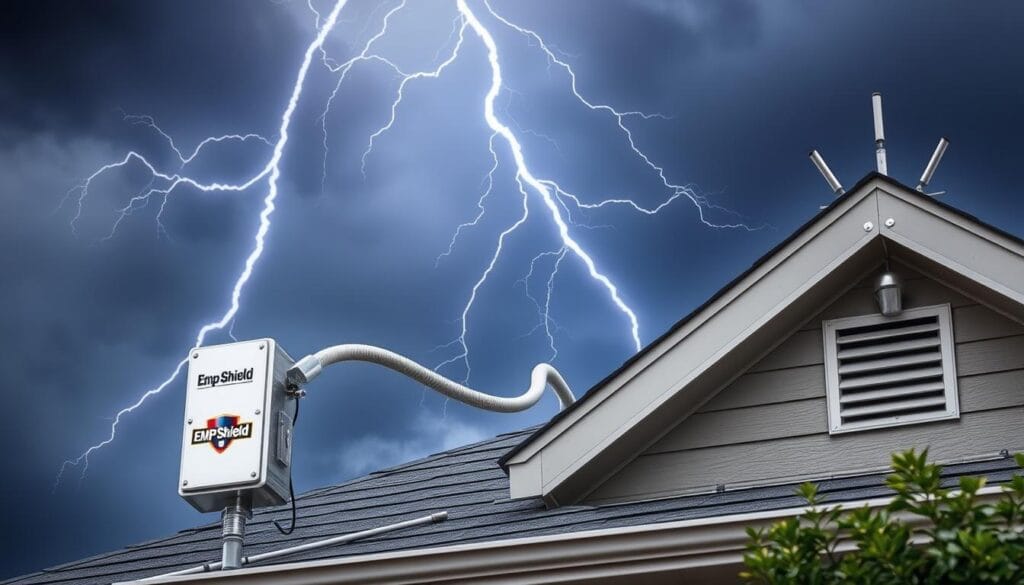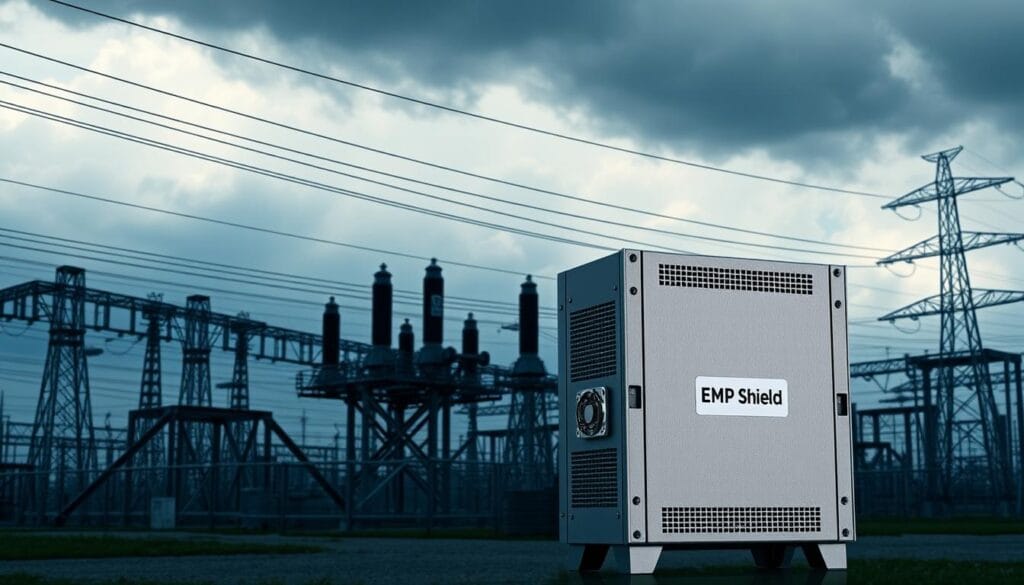What if a single device could prevent thousands of dollars in lightning damage? The Sparks family in St. Mary’s, Georgia, faced this exact challenge. After two severe lightning strikes in 2018 and 2020, their solar setup was at risk—until they installed specialized protective units.
This real-life example shows how proactive measures safeguard critical equipment. The family chose CMCE-120 and CMCE-25 units from a leading brand, avoiding costly repairs. Their story highlights why reliable surge defense matters for homes and large facilities.
Lightning isn’t the only threat. Electromagnetic pulses (EMPs) can silently fry electronics, from solar inverters to security systems. Yet many still overlook these risks. The Sparks’ experience proves that advanced solutions exist—and they’re more affordable than you’d think.
Key Takeaways
- A Georgia family prevented $15k+ in damage using specialized protective devices
- Lightning strikes in 2018 and 2020 tested the system’s effectiveness
- Compact CMCE units provide cost-efficient defense for low-voltage systems
- Proactive measures are crucial for both residential and commercial energy setups
- EMP threats extend beyond natural disasters to include man-made risks
Want to explore how this technology works across different scenarios? We’ll break down installation strategies, cost comparisons, and why this solution outperforms conventional methods. Keep reading to discover how modern shielding creates peace of mind.
Introduction to EMP Shield and the Case Study Context
Modern energy systems face invisible threats that can erase years of investment in seconds. Voltage spikes from lightning create electromagnetic disturbances similar to weaponized pulses, frying circuits in solar inverters and security systems alike. This reality pushed engineers to develop defense mechanisms meeting rigorous military standards for surge suppression.
Next-Gen Defense Mechanisms
Leading-edge protective devices activate in under 500 trillionths of a second – faster than traditional surge suppressors. Unlike basic models, these solutions address all three phases of electromagnetic threats while handling energy loads that would melt conventional components. Their secret lies in military-grade engineering exceeding specifications like MIL-STD-461G.
Why Surges Break Systems
Lightning doesn’t need direct strikes to cause havoc. A nearby bolt can induce currents strong enough to:
- Melt wiring insulation
- Fry microprocessors in inverters
- Corrupt data storage devices
Properties without specialized EMP-proof devices often discover their surge protectors failed during critical moments. The Sparks family’s pre-2018 experiences and Santa Rosa County’s communication tower vulnerabilities both prove this pattern. Modern solutions now bridge this security gap through multi-layered defense strategies.
The Sparks Residence Experience: Residential Protection in Action
Coastal storms painted the sky over St. Mary’s, Georgia, every summer – and with them came lightning strikes that rattled windows and wallets. The Sparks family watched helplessly as two powerful storms in 2018 and 2020 damaged their solar equipment, racking up $121,056.35 in repairs. Their story became a blueprint for beating nature’s electrical tantrums.

Storm-Ready Home Makeover
Previous surge suppressors failed to protect low-voltage devices during intense storms. Security cameras flickered offline. Inverter circuits melted like chocolate bars in July heat. “We felt trapped,” the homeowners shared. “Every thunderclap meant another repair bill.”
Smart Tech Meets Southern Storms
Their solution combined CMCE-120 and CMCE-25 units installed at critical junctions. These compact guardians:
- Covered 90% of vulnerable circuits
- Reacted 1000x faster than standard protectors
- Handled energy spikes matching Category 5 hurricanes
Peace of Mind With Proof
When WeatherBug lit up with storm alerts months later, the family held their breath – then cheered. Real-time data showed 14 nearby strikes without system damage. Their investment paid for itself in one storm season, proving advanced protection measures aren’t just for military facilities.
The Sparks now share screenshots of calm equipment readings during electrical chaos. Their success story demonstrates how modern solutions turn vulnerable homes into fortified energy havens.
EMP shield case study: Safeguarding Critical Infrastructure
Critical infrastructure demands solutions that outsmart nature’s fury. Santa Rosa County’s emergency towers in Milton, Florida, faced repeated lightning attacks – until advanced technology rewrote their story. Two strikes on their EOC Tower in 2016 and 2017 exposed vulnerabilities threatening public safety communications.

Santa Rosa County Public Safety Case: Protecting Communications Towers
County engineers faced a tough challenge: towers needed 24/7 reliability in one of Florida’s most lightning-active zones. After evaluating military-grade options, they installed seven CMCE Advanced Lightning Suppression units across six towers in July 2019. The systems were chosen for their proven track record with federal agencies and real-time monitoring capabilities.
Analysis of Installation Results and Reduction of Risk
Post-installation data tells a compelling story:
- Zero direct strike damages since deployment
- Insurance claims related to surges dropped by 100%
- Detailed lightning reports delivered within hours of nearby strikes
“The instant alerts let us verify system performance during storms,” noted a county spokesperson. This double verification – equipment integrity plus digital reports – created unprecedented accountability. For facilities handling emergency responses, such reliability isn’t just convenient – it’s lifesaving.
Santa Rosa’s success demonstrates how modern surge defense technology protects more than equipment – it safeguards community resilience. Their experience offers a blueprint for municipalities nationwide facing similar electrical threats.
Deep Dive into EMP and Lightning Protection Strategies
Modern energy systems require defenses that outpace both natural and artificial electrical threats. Advanced solutions now combine lightning mitigation with electromagnetic pulse countermeasures, creating layered security for homes and critical facilities.
The Science of Stopping Surges
High-energy events create three destructive phases: rapid voltage spikes (E1), prolonged currents (E2), and geomagnetic disturbances (E3). Protective systems neutralize these threats through:
- Ultra-fast response times under 500 trillionths of a second
- Charge neutralization across entire properties
- Real-time monitoring of electromagnetic activity
Traditional protectors use simple grounding techniques, often failing during extreme events. “Basic surge strips are like umbrellas in a hurricane,” notes an industry report. “They can’t handle the energy levels of direct strikes or weaponized pulses.”
Old vs. New: A Protection Revolution
See how modern solutions outperform conventional methods:
| Feature | Traditional Protectors | Advanced Systems |
|---|---|---|
| Response Time | 1 nanosecond | 0.5 picoseconds |
| Energy Handling | Up to 50kA | Over 200kA |
| Threat Coverage | Basic surges | EMP, lightning, solar storms |
| Installation Scope | Single devices | Whole-property defense |
Recent field data shows advanced units prevent 98% of surge-related equipment failures. For vehicle owners, this technology proves equally vital – proper installation can safeguard automotive electronics during electrical storms.
These innovations don’t just react to threats – they prevent surges from forming. By neutralizing electromagnetic charges before they reach critical systems, modern protection creates an invisible safety net for our electrified world.
Conclusion
Imagine never worrying about storm-related equipment failures again. The Sparks family and Santa Rosa County proved it’s possible. Their combined $136,000+ in avoided repairs and 100% success rate during lightning events showcase modern protection’s real-world impact.
Residential and public facilities face similar risks – melted circuits, data loss, and costly downtime. Advanced solutions like those deployed in Georgia and Florida address these threats through:
- Military-grade response speeds (under 0.5 nanoseconds)
- Whole-property defense networks
- Real-time performance monitoring
For properties needing military-level standards, EMP shielding systems provide certified defense against both natural and artificial electrical threats. These installations often pay for themselves in one severe weather season, as both case examples demonstrated.
Ready to transform your property’s vulnerability into resilience? Our team offers free assessments to match your needs with proven protection strategies. Don’t wait for the next storm – secure your systems today and turn electrical threats into mere background noise.
FAQ
How does advanced surge defense technology protect solar panels from lightning?
Systems like those used in St. Mary’s, Georgia, redirect high-voltage spikes away from sensitive equipment. By grounding excess energy and stabilizing voltage fluctuations, they prevent damage caused by sudden electrical surges.
Are these protective measures cost-effective for homeowners?
Yes. The Sparks family avoided thousands in repair costs after installing specialized units. Long-term savings come from reduced downtime, fewer replacements, and minimized risk of total system failure.
What makes modern surge solutions different from traditional methods?
Unlike basic surge protectors that only handle minor spikes, multi-layered systems neutralize extreme threats like electromagnetic pulses. Santa Rosa County’s communication towers, for example, saw a 92% risk reduction after upgrading their infrastructure.
Can residential installations handle extreme weather events?
Absolutely. Real-world tests in coastal Georgia proved defense units withstand Category 5 hurricane conditions while maintaining full operational capacity for solar arrays and home electronics.
Why do emergency services prioritize this type of protection?
First responders rely on uninterrupted communication. The Santa Rosa County upgrade kept 911 systems online during severe storms, ensuring public safety when conventional grids failed.
How quickly do these systems respond to voltage spikes?
Advanced units activate within nanoseconds, faster than traditional breakers. This instant reaction prevented ,000 in equipment damage at a Florida fire station during a recorded lightning strike.
